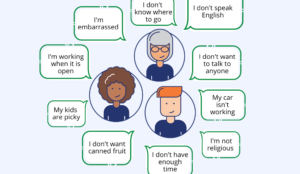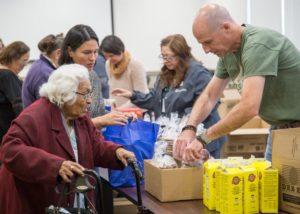Dairy foods like milk, cheese and yogurt are some of the most requested, yet least available foods in food bank networks. For example, on average, families relying on food bank networks only receive one gallon of milk per year. Food banks and their agencies play an important part in supporting a successful food system and increasing the availability of dairy can help them do so. Here’s how dairy is uniquely positioned to help food bank networks.
Closing Supply Gaps
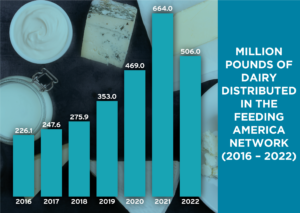 Dairy foods are a readily available and affordable source of nutrition for many people in the U.S. and they arrive at the store fresh. In fact, most fluid milk makes it from the nation’s nearly 28,000 dairy farm families to local supermarkets in about 48 hours. Despite its availability, dairy sourcing for food bank networks can be a challenge due to a lack of refrigerated delivery and storage capacity. The dairy community, in partnership with Feeding America, has worked to solve some of those challenges. In fact, dairy distribution in Feeding America has grown from 353 million pounds in 2019 to 506 million pounds in 2022.
Dairy foods are a readily available and affordable source of nutrition for many people in the U.S. and they arrive at the store fresh. In fact, most fluid milk makes it from the nation’s nearly 28,000 dairy farm families to local supermarkets in about 48 hours. Despite its availability, dairy sourcing for food bank networks can be a challenge due to a lack of refrigerated delivery and storage capacity. The dairy community, in partnership with Feeding America, has worked to solve some of those challenges. In fact, dairy distribution in Feeding America has grown from 353 million pounds in 2019 to 506 million pounds in 2022.
Through government programs, such as The Emergency Food Assistance Program (TEFAP) and partnerships with dairy processors, food bank networks have created a consistent supply of dairy foods for their clients. Further, the U.S. dairy community is committed to addressing the issue of food insecurity in America. Each year, dairy staff works with local food banks to provide milk and dairy foods and the essential nutrients they provide to those in need. Here is just one story about how a dairy organization supports food banks in their area.
Closing Nutrient Gaps
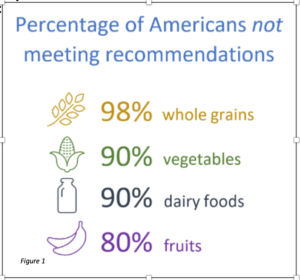 Dairy foods are a rich source of essential nutrients, including calcium, protein, vitamins D and B12.. Dairy foods are also a very affordable source of three of the four nutrients of public health concern – calcium, potassium and vitamin D. In fact, dairy foods provide more than half of the calcium and vitamin D found in American diets. These nutrients are crucial for overall health, especially for vulnerable populations, including children, pregnant women and older adults. By incorporating dairy into food assistance programs, it can help bridge nutritional gaps and support the development and overall well-being of individuals facing food insecurity.
Dairy foods are a rich source of essential nutrients, including calcium, protein, vitamins D and B12.. Dairy foods are also a very affordable source of three of the four nutrients of public health concern – calcium, potassium and vitamin D. In fact, dairy foods provide more than half of the calcium and vitamin D found in American diets. These nutrients are crucial for overall health, especially for vulnerable populations, including children, pregnant women and older adults. By incorporating dairy into food assistance programs, it can help bridge nutritional gaps and support the development and overall well-being of individuals facing food insecurity.
Closing Access Gaps
Dairy foods contribute to a diverse and balanced diet. They provide a range of flavors, textures and culinary possibilities, enhancing the overall enjoyment and variety of meals, as well as cultural relevancy for food pantry clients. Dairy foods like milk, cheese and yogurt play an important role in the diets of many cultures, so ensuring access to these foods assists in creating equity for the variety of cultures that food bank systems serve.
Dairy is an important food group for closing access gaps when considering cost, as well. Milk, cheese and yogurt can be affordable options for community members and food bank networks alike—for example, on average, an 8-ounce serving of milk costs about 22 cents.
A Unique Solution for Food Banks & Pantries
Ultimately, dairy foods are unique in their results for successful food systems, food bank networks and food-insecure communities. With its ability to close supply, nutrient and access gaps, dairy is a versatile food group that helps support the health and well-being of our communities’ vulnerable members.
Dairy goes beyond an affordable and nutritious solution—it also can be a sustainable and environmentally-sound solution for food bank clients. Dairy foods provide nearly 20% of the protein and more than 50% of the calcium and vitamin D in American diets, while accounting for about 2% of the U.S.’s greenhouse gas emissions.
You can learn more about how food banks and the dairy community have joined together to increase access to nutritious dairy foods at www.DairyNourishesAmerica.org. Check out the results of the Dairy Nourishes America Midwest symposium to help you start your journey to growing access to dairy for your clients.
Get Help From Your Local Dairy Council
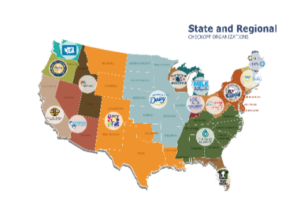 Find your local dairy council for resources to support your efforts in increasing access to dairy, like educational materials, connections to dairy processors and more. Some state and regional dairy councils even offer grants and donation model ideation. You can also learn more about how dairy foods like milk, cheese and yogurt fit into your food bank network by exploring information from National Dairy Council.
Find your local dairy council for resources to support your efforts in increasing access to dairy, like educational materials, connections to dairy processors and more. Some state and regional dairy councils even offer grants and donation model ideation. You can also learn more about how dairy foods like milk, cheese and yogurt fit into your food bank network by exploring information from National Dairy Council.
This article is a sponsored post.
Connect with Us:


